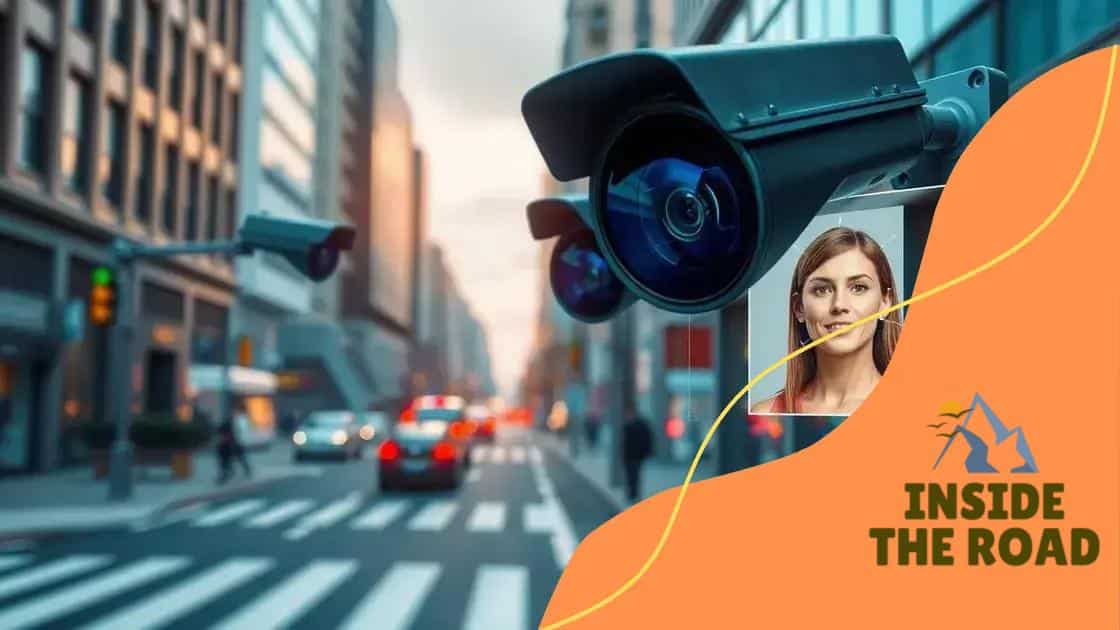The role of facial recognition in enhancing public safety

The role of facial recognition in enhancing public safety involves improving law enforcement efficiency, enabling faster investigations, and providing better security in public spaces, while also raising significant privacy concerns that necessitate careful regulation.
The role of facial recognition in enhancing public safety is a topic that sparks interest and debate. As more cities adopt this technology, it raises questions about effectiveness and privacy. How does it impact our daily lives?
Understanding facial recognition technology
The understanding of facial recognition technology begins with how it works. This technology analyzes the unique features of a person’s face to create a digital representation. In recent years, it has become increasingly popular in enhancing public safety. By identifying individuals in real-time, law enforcement agencies can respond to incidents faster.
How Facial Recognition Works
Facial recognition systems use algorithms to detect and recognize faces. When a camera captures an image, the system measures various facial features. These features are then converted into a numerical value. This value is compared to a database to identify or verify a person’s identity.
Key Components of the Technology
- Image Capture: Cameras with high resolution capture facial images.
- Feature Extraction: Algorithms identify facial landmarks.
- Matching Process: The extracted features are matched against a database of known faces.
- Decision Making: The system determines whether the match is a positive identification.
Moreover, the use of facial recognition extends beyond just identifying criminals. It can enhance security in public spaces, such as airports and stadiums. By watching for suspicious behavior, authorities can take action before incidents occur. This proactive approach could significantly improve public safety.
Despite its benefits, there are serious concerns about privacy and accuracy. Critics argue that surveillance technology could lead to misuse, such as wrongful accusations. It’s essential to discuss these implications while also considering how to implement this technology responsibly.
Ultimately, understanding how facial recognition technology works allows us to appreciate its potential and challenges. It highlights the need for clear regulations to protect individual rights while enhancing safety.
Benefits for law enforcement
The benefits for law enforcement using facial recognition technology are significant and multifaceted. This technology aids officers in solving crimes more efficiently and enhances public safety in various ways. As police departments adopt these systems, the impact on their operations becomes clearer.
Speeding Up Investigations
One of the primary advantages is the speed it brings to investigations. By quickly identifying suspects through facial recognition, police can close cases much faster than traditional methods. Officers no longer have to rely solely on eyewitness accounts, which can be unreliable.
Enhancing Public Safety
- Real-time monitoring: Facial recognition allows for real-time surveillance in crowded areas.
- Identifying suspects: It can help identify suspects involved in active crimes.
- Preventing crime: The presence of surveillance can deter criminal activities.
- Tracking missing persons: The technology can also help locate missing individuals quickly.
Furthermore, the technology increases the accuracy of identifications. With algorithms improving, false positives decrease, ensuring innocent people are not wrongly accused. This enhances trust between communities and law enforcement as they see effective implementation of such technologies.
However, it is essential for law enforcement agencies to use this technology responsibly. Adopting proper protocols can mitigate privacy concerns while still leveraging the benefits of facial recognition. Training officers to understand the ethical implications plays a crucial role in establishing community trust and safety.
In conclusion, while the technology presents challenges, the benefits for law enforcement are evident. By enhancing the speed and accuracy of investigations and bolstering public safety, facial recognition technology is a powerful tool when used appropriately.
Privacy concerns and regulations

Addressing privacy concerns and regulations surrounding facial recognition technology is crucial for its responsible implementation. As this technology becomes more prevalent, individuals are increasingly aware of how their data is collected and used. The balance between enhanced security and personal privacy must be carefully considered.
Understanding Privacy Issues
One major concern is the potential for misuse of data. Governments and organizations could access sensitive information without consent, leading to a violation of privacy rights. Individuals may feel uncomfortable knowing that their faces could be monitored in public spaces.
Essential Regulations
- Data Protection Laws: Regulations like GDPR in Europe establish rules for data collection and user consent.
- Usage Policies: Agencies must clearly define how facial recognition data will be used.
- Accountability Measures: There should be protocols in place for addressing misuse or breaches of data.
- Public Transparency: Law enforcement should inform the public about surveillance programs.
The need for clear regulations grows as facial recognition technology evolves. These rules should govern how data is collected, stored, and shared. Developing guidelines can help alleviate public fears and foster trust between communities and law enforcement.
Another significant issue arises from the inaccuracies of facial recognition systems. When these systems incorrectly identify individuals, it can lead to wrongful accusations. It is vital to ensure these technologies are tested for accuracy before deployment.
Having a thoughtful discussion about privacy concerns and regulations is essential. By establishing robust policies, society can reap the benefits of facial recognition while protecting individual rights.
Real-world examples of use
Exploring real-world examples of use for facial recognition technology demonstrates its effectiveness in various settings. Many cities and organizations have implemented this technology to enhance safety and efficiency. Each case provides insights into the benefits and challenges faced.
Case Study: Law Enforcement
In several major cities, police departments have adopted facial recognition systems to aid in crime-solving. For instance, in Chicago, law enforcement successfully identified suspects in theft and robbery cases using cameras installed in public areas. This quick identification process helped reduce crime rates and increase response times.
Airport Security Enhancements
A significant application of facial recognition is seen in airport security. Airports such as Singapore Changi and Dubai International have integrated the technology into their security protocols. Travelers can experience faster check-ins and boarding processes by verifying their identities through facial recognition instead of traditional methods. This not only improves efficiency but also enhances security measures.
Retail Environments
- Loss Prevention: Retailers are using facial recognition to detect known shoplifters as they enter stores. This proactive approach helps reduce theft.
- Customer Insights: Stores analyze customer demographics through facial recognition, allowing them to tailor marketing strategies.
- Enhanced Security: Stores can monitor for suspicious behavior to prevent potential issues before they escalate.
Additionally, facial recognition is being used in event security management. Large-scale events, such as concerts and sports games, utilize this technology for crowd management. By quickly identifying potential threats, organizers can take action to ensure attendee safety.
While these examples highlight the benefits of facial recognition technology, they also show the need for careful consideration of privacy issues. The success of these implementations depends on the responsible use of the technology.
Future trends in facial recognition
The future trends in facial recognition technology are evolving rapidly, influenced by advancements in artificial intelligence and machine learning. As this technology continues to develop, it promises to enhance security and personalization in various sectors.
Increased Accuracy and Reliability
One trend is the improvement in accuracy rates for facial recognition systems. With more sophisticated algorithms and larger training datasets, future systems will likely reduce false positives and negatives. This means that technology will identify individuals more reliably, which is crucial for law enforcement and security applications.
Integration with Other Technologies
Another trend is the integration of facial recognition with other forms of biometric identification. Systems may combine facial recognition with voice recognition or fingerprint scanning. This multi-factor authentication will enhance security measures significantly. Organizations can ensure that only authorized individuals gain access to sensitive areas or information.
Regulatory Changes and Ethical Considerations
- Stricter Regulations: As facial recognition becomes more common, governments may impose stricter regulations to protect individual privacy.
- Ethical Use: Companies will focus on ethical considerations, ensuring transparency in how data is collected and used.
- Public Awareness: Increased public awareness about privacy concerns will shape how facial recognition technology is adopted.
- Community Engagement: Organizations will engage communities in discussions about the acceptable use of this technology.
The rise of edge computing is also set to transform facial recognition technology. By processing data closer to where it is captured, these systems can deliver faster results and reduce congestion on networks. This shift will be especially beneficial in high-traffic areas, where real-time responses are crucial.
Overall, the future of facial recognition holds great potential for various applications, from enhancing security measures to personalizing customer experiences. However, to realize its full potential, stakeholders must prioritize responsible and ethical use, ensuring that individual rights are protected.
FAQ – Frequently Asked Questions about Facial Recognition Technology
How does facial recognition technology improve public safety?
Facial recognition technology enhances public safety by quickly identifying suspects and monitoring public spaces for suspicious behavior.
What are the privacy concerns associated with facial recognition?
Privacy concerns include potential misuse of data, surveillance without consent, and the risk of wrongful identification.
How accurate is facial recognition technology?
The accuracy of facial recognition technology is improving with advanced algorithms, but issues with false positives still exist.
What regulations are in place for facial recognition use?
Various regulations are being developed to protect privacy rights, requiring transparency and accountability in how the technology is used.






